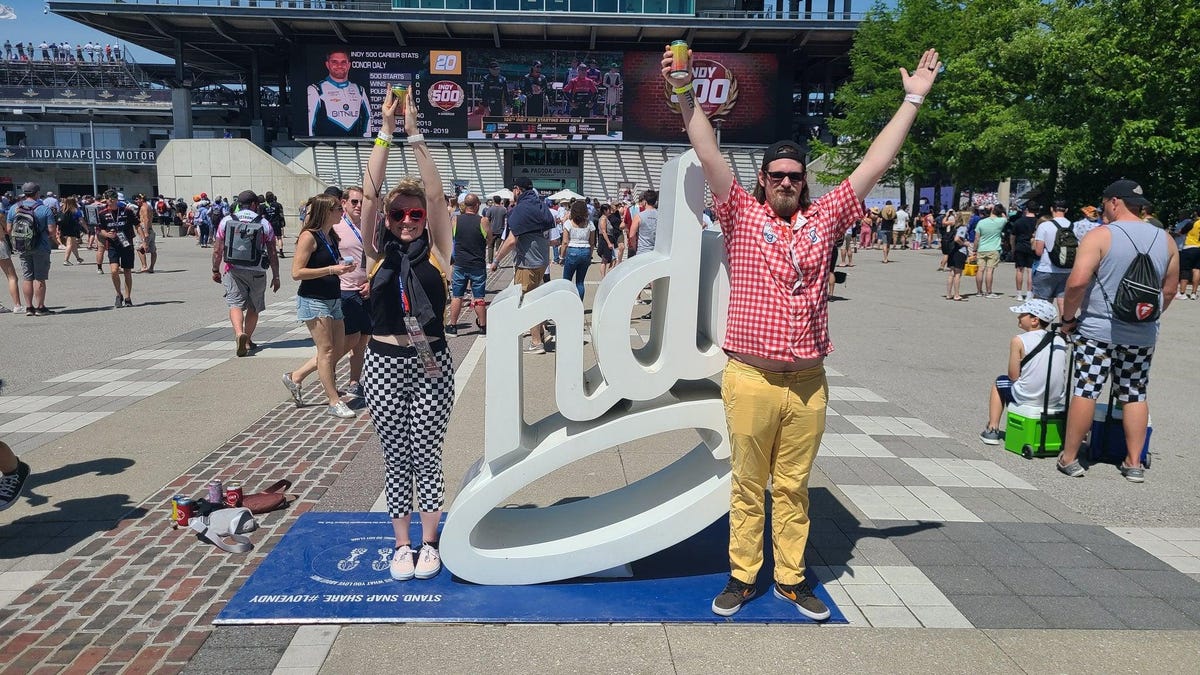The Indianapolis 500: You Don't Know What Indy Means

The Blackstocks were IndyPhoto: Elizabeth Blackstock
You don’t know what Indy means. I lost track of the number of times I saw that phrase on a t-shirt, coozie, or cooler as I wandered around the Indianapolis Motor Speedway during the 2022 Indy 500 race weekend. It’s a phrase that used to make me roll my eyes, that still makes my husband scoff. But this year — my first time as a member of the Indy 500 media and my first time at the race since the onset of the COVID-19 pandemic — that phrase stuck with me. It rang in my head all weekend. You don’t know what Indy means.
Full disclosure: Firestone paid for my husband and I to attend the 2022 Indianapolis 500 and absolutely spoiled me along the way with nice dinners and at-track air conditioning. For the first time in my life, I watched the race as a VIP, not as one of the sunburned, unwashed masses. Unfortunately, they have also totally ruined my husband, who had the full experience for his first 500.
It doesn’t matter when you go, or how many years you’ve been going. It doesn’t matter if it’s your first time or your 50th. The Indianapolis Motor Speedway is hallowed ground for motorsport fans, and walking into the modernized facility, you still get that ghostly sense of history lingering just under your feet. This is a place where drivers have had the best day of their lives, the place where other drivers have lost theirs. The Indy 500 is the race that has consistently changed the course of motorsport and automotive history, and it’s apparent to everyone who enters the gates on race day morning — whether you’re there as a hardcore race fan or if you just plan to have a few drinks and get rowdy in the Snake Pit.
This year was my first as media and not a fan, my first as a VIP hosted by Firestone, and my first back at the track since the onset of COVID-19. Before I boarded my flight to Indianapolis, I wondered how it would feel to be back. I was excited, yes — but would I be too busy to appreciate such a monumental personal achievement? Would I be running around too much, chasing interviews and heading to media events, to bask in the simple luxuries of being an IndyCar fan at the series’ biggest race? It was hard to know.
As the pre-race ceremonies started, though, the hair on my arms started to raise. My heart rate increased. I started to get antsy as I talked to my friends, knowing that the sooner I got to my seats, the sooner I’d be watching the on-track action unfold before me, even if it was simply in the form of a driver introduction. There’s so much pomp and circumstance, there are so many layers of tradition, and every year, I see people criticizing the American excess, and I can’t help but think that one phrase: you don’t know what Indy means.
It’s hard to get it until you’ve been there. I remember rolling my eyes and complaining about complex race formats and old-timey rules. And then I went to the 100th running of the race. And then I showed up for the full Month of May. And then I kept coming back. And then I watched from home during the pandemic, and — as melodramatic as it sounds — it felt like a part of my heart had left me behind to take a little vacation in Indianapolis.
This year, as the first tones of “Back Home Again in Indiana” rolled out over the crowd, I lost control of the tears I’d been biting back as the tension mounted. No matter who took the checkered flag at the end of 500 grueling miles, I would be witnessing a beautiful moment in history — which is such a welcome change from living through this current, constant barrage of deeply horrifying once-in-a-lifetime events.
One driver would walk away with his face carved into the Borg-Warner trophy. Would it be an already-established icon further emphasizing his place in the motorsport record books? Would a struggling driver’s win revitalize his career? Would it be a first-timer? A rookie? A veteran? And what would it take to last through nine pit stops, countless yellow flags, and the beating heat of a hot summer day?
No matter the outcome, it would be beautiful. And if you could watch those pre-race ceremonies and wonder why we need to go through all that effort for one silly little motor race, well — you just don’t know what Indy means.



